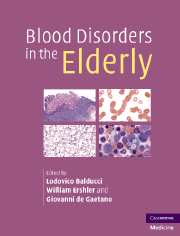Book contents
- Frontmatter
- Contents
- List of contributors
- Preface
- Part I Epidemiology
- Part II Hematopoiesis
- Part III Anemia of aging
- Part IV Hematologic malignancies and aging
- Part V Disorders of hemostasis in the elderly
- 26 Acquired hemophilia in the elderly
- 27 Blood coagulation and aging
- 28 Platelet disorders in the elderly
- 29 Gene—environment interactions and vascular risk in the elderly
- 30 Antithrombotic therapy: guidelines for the elderly
- Index
29 - Gene—environment interactions and vascular risk in the elderly
from Part V - Disorders of hemostasis in the elderly
Published online by Cambridge University Press: 21 October 2009
- Frontmatter
- Contents
- List of contributors
- Preface
- Part I Epidemiology
- Part II Hematopoiesis
- Part III Anemia of aging
- Part IV Hematologic malignancies and aging
- Part V Disorders of hemostasis in the elderly
- 26 Acquired hemophilia in the elderly
- 27 Blood coagulation and aging
- 28 Platelet disorders in the elderly
- 29 Gene—environment interactions and vascular risk in the elderly
- 30 Antithrombotic therapy: guidelines for the elderly
- Index
Summary
Introduction
Prospective studies have demonstrated a positive association between plasma levels of proteins involved in hemostatic mechanisms and the development of atherothrombotic disease in individuals of either sex. The genetic factors that modulate the individual susceptibility to multifactorial diseases such as cardiovascular diseases are common polymorphisms which generally have a modest effect at an individual level, but, because of their high frequency in the population, can be associated with a high attributable risk. Potential synergistic gene–environment interaction can reveal or facilitate the phenotypic expression of such susceptibility genes. Common biallelic polymorphisms of many genes encoding for coagulation and fibrinolysis proteins influence the plasma levels of these proteins. Cardiovascular diseases (e.g., myocardial infarction, angina, and stroke) reach epidemic proportions in the elderly and are the primary limits to survival in humans. In the last decades particular attention has been paid to cardiovascular risk factors in the elderly, and genetic epidemiological studies of the diseases of aging are increasing rapidly. Many aspects of aging involve inflammation. Age-related disease such as atherosclerosis are triggered or worsened by systemic chronic inflammation. Some traditional risk factors lose importance as predictors of atherothrombotic diseases, and the role of novel cardiovascular risk factors such as clotting and fibrinolytic proteins emerges.
- Type
- Chapter
- Information
- Blood Disorders in the Elderly , pp. 434 - 447Publisher: Cambridge University PressPrint publication year: 2007



